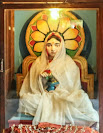The Whole Nine Yards
As a child I found comfort in cuddling a soft, warm, dry and fluffy white mass. No, it wasn’t a puppy! It was my grandmother’s nine yard saree (“nauvari”; nau- nine, var - yard; in Marathi) stitched like a quilt. It was extremely soft, being well-worn cotton and washed hundreds of times, folded four times and stitched into a comfortable quilt of a little over 6 feet in length, hence named “chaughadi” (chau - four, ghadi - fold; in Marathi). In the Indian winters it would trap the body heat and provide just enough warmth, and in summers, the airy, light material was the perfect cover under a ceiling fan. Beyond the practical perfectness, it was my inseparable security blanket. So when I first heard the phrase “the whole nine yards” in the US, however bizarre it may sound now, I assumed it was borrowed from the length of the traditional Indian saree. To me the phrase made complete sense - to go the full length or detail into something, as compared to the more modern, and shorter, abridged length of six yards (sahavari).
I grew up in a city which was historically called Ahilyanagari in the 18th century, after its spiritual philosopher Queen Ahilyabai Holkar. Her dressing style, which I saw in pictures all around me, reminded me of my grandmother. In her ~30 year reign, from 1767 to 1795, the progressive, just, scrupulous and virtuous ruler, who was known for her impeccable administrative skills, brought peace and prosperity to Indore, as the city is called now. Simply dressed in a white nauvari, she kept a strict separation between the government revenue, which went towards the betterment of her subjects and her personal property and inheritance, which she mostly donated towards charity in infrastructure projects like rebuilding temples and constructing wells, rest-houses and ghats all over India. A widow at 21, she was an example of progressive thinking when she moved beyond the Sati pratha to hold the reigns of her otherwise collapsing State. In my mind she epitomizes “the whole nine yards”, not simply in the way she dressed, but in the way she governed her kingdom and became a dominant force in central India.
Another inspiring trailblazer from the 19th century, Anandi Gopalrao Joshi, the first lady doctor of Indian origin, started her journey dressed in nauvari, which was the traditional attire during those times. Despite the strong opposition from society in her pursuit of education, her progressive husband Gopalrao Joshi stood steadfast by her side. She was awarded her Medical degree from the Women’s Medical College of Pennsylvania in 1886. Her MD thesis was titled “Obstetrics Among the Aryan Hindoos” where she incorporated elements from both Western medicine and Ayurveda. In a progressive trend and to protect her ailing health due to tuberculosis, she traded her traditional nauvari to the more layered sahavari saree to adjust to the cold climate in America.
In the early 20th century, while some women were moving towards the more convenient six yard sarees, an unlikely model and designer for the nauvari ensemble became a rage for feminine fashion. When Bal Gandharva stepped on stage, most gracefully dressed for female roles, he mesmerized everyone with his performance; though women were beyond smitten with his dressing style. In an era when women were not allowed on stage, Narayan Sripad Rajhans filled in the gap with finesse. There is a recent movie about Bal Gandharva’s tale of feminine mystique.
Towards the later part of the 20th century, the more practical sahavari had taken over as the popular attire for women who favored sarees, though nauvari continued to have a presence in rural Maharashtra and of course, in movies. Over years nauvari worn in the adapted-movie-lavani style has established its spot in the movies to the chagrin of the traditionally minded folks. Every now and then one could hear the judgmental tongue-in-cheek and amusing remarks about “how nine yards of material was unsuccessful in its primary function as a body cover”. However, I credit Bollywood for reintroducing, popularizing, modernizing and glamorizing the traditional dressing style in the 21st century. A recent movie Bajirao Mastani filmed a very hit song “Pinga Pinga” with popular actresses Priyanka Chopra (Jonas) and Deepika Padukone dressed in nauvari.
To me all these folks represent individuality and progress in the context of their respective era. The whole nine yards fascinated me - from the white cotton that my grandmother chose to wear; to the grand, colorful “Paithanis” worn with full Maharashtrian jewellery that younger women chose to wear. While I prefer the more convenient lighter dressing styles myself, it is exciting to see the younger generation accepting and embracing this elaborate attire once again (picture is from my niece Anjani's marriage with Ashwin). It is always interesting to see my Mom, Aunts and other family members dress up traditionally, in the whole nine yards, on special occasions and weddings. As my curiosity got the better of me, to dig out what William Safire called “one of the great etymological mysteries”, to me it is as plain as the nose on a face - it is the whole nine yards of a nauvari saree!













Lai bhari
ReplyDeleteInteresting write up.
ReplyDeleteInteresting !
ReplyDeletetumhi khup mast lihita ... maja aali vachatana
ReplyDeleteTreasure of childhood.
ReplyDeleteVery well written!
ReplyDelete